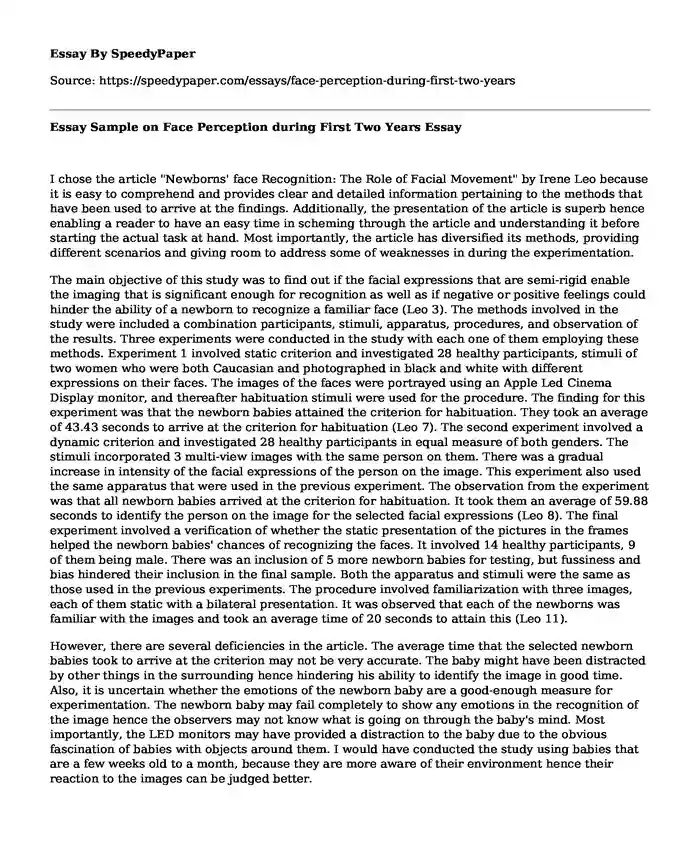
| Type of paper: | Essay |
| Categories: | Child development |
| Pages: | 3 |
| Wordcount: | 633 words |
I chose the article "Newborns' face Recognition: The Role of Facial Movement" by Irene Leo because it is easy to comprehend and provides clear and detailed information pertaining to the methods that have been used to arrive at the findings. Additionally, the presentation of the article is superb hence enabling a reader to have an easy time in scheming through the article and understanding it before starting the actual task at hand. Most importantly, the article has diversified its methods, providing different scenarios and giving room to address some of weaknesses in during the experimentation.
The main objective of this study was to find out if the facial expressions that are semi-rigid enable the imaging that is significant enough for recognition as well as if negative or positive feelings could hinder the ability of a newborn to recognize a familiar face (Leo 3). The methods involved in the study were included a combination participants, stimuli, apparatus, procedures, and observation of the results. Three experiments were conducted in the study with each one of them employing these methods. Experiment 1 involved static criterion and investigated 28 healthy participants, stimuli of two women who were both Caucasian and photographed in black and white with different expressions on their faces. The images of the faces were portrayed using an Apple Led Cinema Display monitor, and thereafter habituation stimuli were used for the procedure. The finding for this experiment was that the newborn babies attained the criterion for habituation. They took an average of 43.43 seconds to arrive at the criterion for habituation (Leo 7). The second experiment involved a dynamic criterion and investigated 28 healthy participants in equal measure of both genders. The stimuli incorporated 3 multi-view images with the same person on them. There was a gradual increase in intensity of the facial expressions of the person on the image. This experiment also used the same apparatus that were used in the previous experiment. The observation from the experiment was that all newborn babies arrived at the criterion for habituation. It took them an average of 59.88 seconds to identify the person on the image for the selected facial expressions (Leo 8). The final experiment involved a verification of whether the static presentation of the pictures in the frames helped the newborn babies' chances of recognizing the faces. It involved 14 healthy participants, 9 of them being male. There was an inclusion of 5 more newborn babies for testing, but fussiness and bias hindered their inclusion in the final sample. Both the apparatus and stimuli were the same as those used in the previous experiments. The procedure involved familiarization with three images, each of them static with a bilateral presentation. It was observed that each of the newborns was familiar with the images and took an average time of 20 seconds to attain this (Leo 11).
However, there are several deficiencies in the article. The average time that the selected newborn babies took to arrive at the criterion may not be very accurate. The baby might have been distracted by other things in the surrounding hence hindering his ability to identify the image in good time. Also, it is uncertain whether the emotions of the newborn baby are a good-enough measure for experimentation. The newborn baby may fail completely to show any emotions in the recognition of the image hence the observers may not know what is going on through the baby's mind. Most importantly, the LED monitors may have provided a distraction to the baby due to the obvious fascination of babies with objects around them. I would have conducted the study using babies that are a few weeks old to a month, because they are more aware of their environment hence their reaction to the images can be judged better.
Works Cited
Leo, Irene, et al. "Newborns' Face Recognition: The Role of Facial Movement." Infancy 23.1 (2018): 1-15
Cite this page
Essay Sample on Face Perception during First Two Years. (2022, May 27). Retrieved from https://speedypaper.com/essays/face-perception-during-first-two-years
Request Removal
If you are the original author of this essay and no longer wish to have it published on the SpeedyPaper website, please click below to request its removal:
- Religion and Politics Essay Sample for Free
- Physician Assisted Suicide Should be Legalized - Free Essay on Euthanasia
- Essay Example on the Imperial Hotel: Poor Guest Satisfaction
- Essay Example about Characteristics of Buddhism as State-Protecting Religion
- Free Essay about the Research Conducted on the Importance of Taking Time to Celebrate
- Review of Rivers and Tides Film - Essay Example
- Essay Example on the Health Care Management Practice Settings
Popular categories




